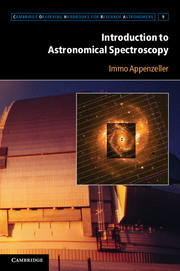Book contents
- Frontmatter
- Contents
- Preface
- 1 Historical Remarks
- 2 Spectroscopy in Present-Day Astronomy
- 3 Basic Physics of Spectral Measurements
- 4 Optical-Range Grating and Prism Spectrometers
- 5 Other Techniques for the Optical Spectral Range
- 6 Preparing and Reducing Optical Observations
- 7 UV, X-Ray, and Gamma Spectroscopy
- 8 Spectroscopy at Radio Wavelengths
- 9 Special Techniques of the FIR and Submillimeter Range
- 10 New Developments and Future Prospects
- Appendix: List of Acronyms
- References
- Index
6 - Preparing and Reducing Optical Observations
Published online by Cambridge University Press: 05 January 2013
- Frontmatter
- Contents
- Preface
- 1 Historical Remarks
- 2 Spectroscopy in Present-Day Astronomy
- 3 Basic Physics of Spectral Measurements
- 4 Optical-Range Grating and Prism Spectrometers
- 5 Other Techniques for the Optical Spectral Range
- 6 Preparing and Reducing Optical Observations
- 7 UV, X-Ray, and Gamma Spectroscopy
- 8 Spectroscopy at Radio Wavelengths
- 9 Special Techniques of the FIR and Submillimeter Range
- 10 New Developments and Future Prospects
- Appendix: List of Acronyms
- References
- Index
Summary
Astronomical observing projects generally can be divided into three phases: (1) the preparation, (2) the actual observations, and (3) the reduction of the collected data.
At most large ground-based telescopes and at all space facilities, the actual observations are executed automatically by means of a dedicated computer program. The program points the telescope, configures the spectrometer, starts the individual observing steps, and stores the resulting data. The observer initiates the observations by entering the observing parameters (such as the target coordinates, the desired instrument configuration, and the integration times) into a data file, which is uploaded to the computer prior to the beginning of the observations. Only at smaller telescopes, during tests, or at seldom-used instruments are the spectrometers operated manually by the astronomer or by an operator.
All observations result in raw spectra, which, in addition to scientific information, contain artifacts caused by the instruments, by backgrounds, and (in the case of ground-based observations) by the Earth's atmosphere. Therefore, in a final (reduction) step, these artifacts must be removed, and the data must be properly calibrated.
This chapter describes mainly how spectroscopic observations are prepared and how the raw data are reduced. As the execution phase follows in a straightforward way from the preparatory work, less space is devoted to the phase of the actual observations.
Planning and Preparing Observing Runs
General Considerations
The planning phase is the most important part of a successful observing run.
- Type
- Chapter
- Information
- Introduction to Astronomical Spectroscopy , pp. 145 - 178Publisher: Cambridge University PressPrint publication year: 2012



